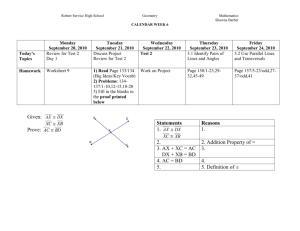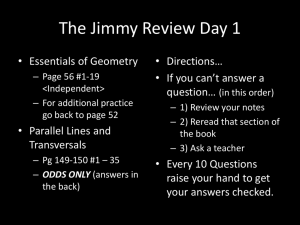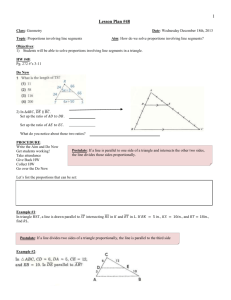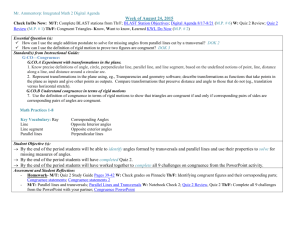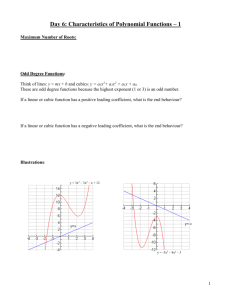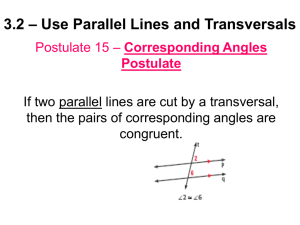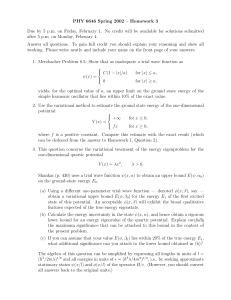REAL QUARTIC SURFACES CONTAINING ISIDRO NIETO
advertisement
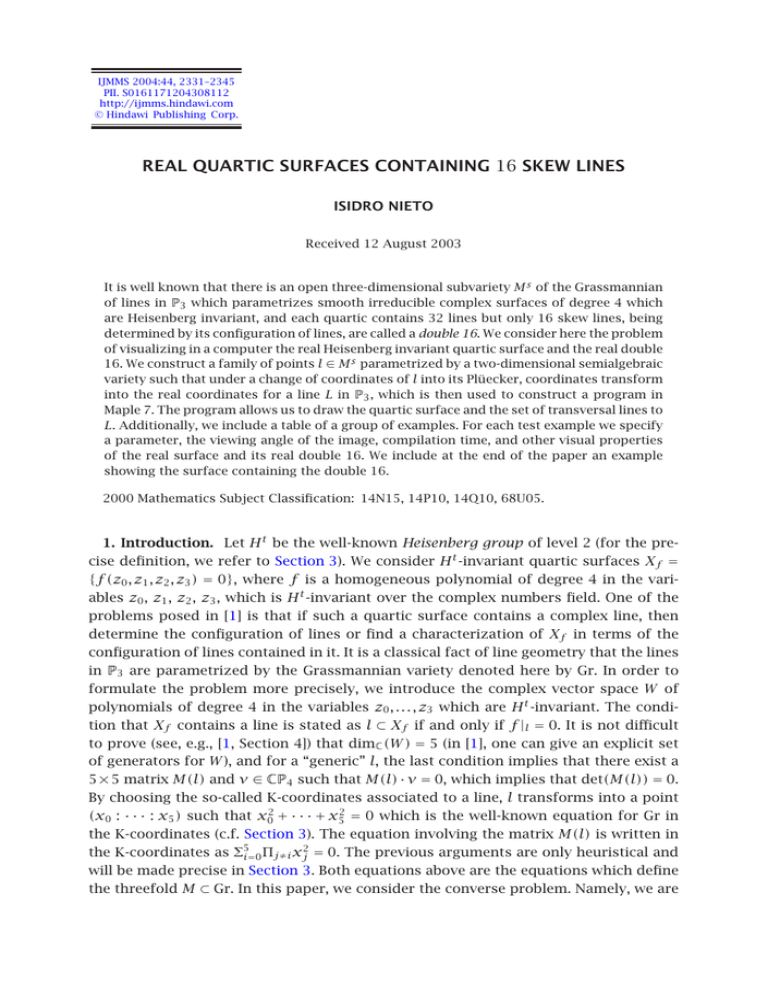
IJMMS 2004:44, 2331–2345
PII. S0161171204308112
http://ijmms.hindawi.com
© Hindawi Publishing Corp.
REAL QUARTIC SURFACES CONTAINING 16 SKEW LINES
ISIDRO NIETO
Received 12 August 2003
It is well known that there is an open three-dimensional subvariety M s of the Grassmannian
of lines in P3 which parametrizes smooth irreducible complex surfaces of degree 4 which
are Heisenberg invariant, and each quartic contains 32 lines but only 16 skew lines, being
determined by its configuration of lines, are called a double 16. We consider here the problem
of visualizing in a computer the real Heisenberg invariant quartic surface and the real double
16. We construct a family of points l ∈ M s parametrized by a two-dimensional semialgebraic
variety such that under a change of coordinates of l into its Plüecker, coordinates transform
into the real coordinates for a line L in P3 , which is then used to construct a program in
Maple 7. The program allows us to draw the quartic surface and the set of transversal lines to
L. Additionally, we include a table of a group of examples. For each test example we specify
a parameter, the viewing angle of the image, compilation time, and other visual properties
of the real surface and its real double 16. We include at the end of the paper an example
showing the surface containing the double 16.
2000 Mathematics Subject Classification: 14N15, 14P10, 14Q10, 68U05.
1. Introduction. Let H t be the well-known Heisenberg group of level 2 (for the precise definition, we refer to Section 3). We consider H t -invariant quartic surfaces Xf =
{f (z0 , z1 , z2 , z3 ) = 0}, where f is a homogeneous polynomial of degree 4 in the variables z0 , z1 , z2 , z3 , which is H t -invariant over the complex numbers field. One of the
problems posed in [1] is that if such a quartic surface contains a complex line, then
determine the configuration of lines or find a characterization of Xf in terms of the
configuration of lines contained in it. It is a classical fact of line geometry that the lines
in P3 are parametrized by the Grassmannian variety denoted here by Gr. In order to
formulate the problem more precisely, we introduce the complex vector space W of
polynomials of degree 4 in the variables z0 , . . . , z3 which are H t -invariant. The condition that Xf contains a line is stated as l ⊂ Xf if and only if f |l = 0. It is not difficult
to prove (see, e.g., [1, Section 4]) that dimC (W ) = 5 (in [1], one can give an explicit set
of generators for W ), and for a “generic” l, the last condition implies that there exist a
5 × 5 matrix M(l) and ν ∈ CP4 such that M(l) · ν = 0, which implies that det(M(l)) = 0.
By choosing the so-called K-coordinates associated to a line, l transforms into a point
(x0 : · · · : x5 ) such that x02 + · · · + x52 = 0 which is the well-known equation for Gr in
the K-coordinates (c.f. Section 3). The equation involving the matrix M(l) is written in
the K-coordinates as Σ5i=0 Πj≠i xj2 = 0. The previous arguments are only heuristical and
will be made precise in Section 3. Both equations above are the equations which define
the threefold M ⊂ Gr. In this paper, we consider the converse problem. Namely, we are
2332
ISIDRO NIETO
interested in finding points in a subvariety of M s ⊂ M (for which a precise definition
will be given in Section 2) such that each point in M s arises as a real line in P3 (i.e.,
defined by real coordinates), the quartic Xf determined by l is real (i.e., the points
are defined in real three-dimensional projective space), and the coefficients of f are
defined over the real numbers field. Moreover, if according to the theory of [1, Section 4], a point in M s generates a complex line which determines a smooth, irreducible
complex H t -invariant quartic surface containing it and its H t orbit, then an easy extension of the theory to the real case shows that for the special case treated here, the
H t -invariant quartic surface Xf is real and its defining polynomial f is real. The next
problem is to find a special hyperplane H ⊂ RP3 to be able to graph Xf ∩ H and visualize it along with its configuration of lines called here a double 16 on a computer. It
is of interest to note that the H t -invariant quartic surfaces containing a complex line
form a three-dimensional complex parameter space within the 34-dimensional space of
quartic surfaces in CP3 . Such surfaces of degree 4 defined over the complex field arise
as projective models of linear systems of abelian surfaces of polarization type (1, 3)
(c.f. [1, 5]).
We give an outline of the paper. In Section 2, we state sufficient conditions for an
arbitrary point l ∈ M to be in M s (Proposition 2.7). We then construct a subset of M s
parametrized by a two-dimensional semialgebraic set (Remark 2.9). In Section 3, after
giving a few basic facts of line geometry and the definition of the Heisenberg group, we
show that the H t -invariant quartic surfaces defined by the points of Proposition 2.7 are
real quartic surfaces and contain the double 16 with real lines, and that the quartics
are determined by the configuration.
In Section 4, we give a detailed description of how the Maple program works and is
used to visualize these surfaces along with their line configurations (to the extent to
which they can be shown) on the computer. In Section 5, we describe the results given
by the program for a group of examples in a table which describes, for the surface
drawn with its ten transversals, the following parameters: d (which defines the quartic
surface; this is the value λ of (2.8)), the angle (u, v) of the image surface, compilation
time for each surface, and the visual description of the double 16. We printed one test
example of a surface for which one can see a line and most of the double 16, at one
specific angle, and it is given at the end of the paper. The program can be used as a
guide to produce Heisenberg invariant Kummer quartic surfaces, which contain other
types of curves, not necessarily rational ones, and can be useful for other researchers
working on similar problems.
2. An elementary proposition and a locus of real solutions. Another more suggestive way of writing the equation for M as defined in [1, Section 4] is
Σ5i=0 xi2 = Σ5i=0
1
= 0.
xi2
(2.1)
In the sequel, the following set of equations, derived from the above definition, will be
more useful to us:
REAL QUARTIC SURFACES CONTAINING 16 SKEW LINES
2333
x02 + x12 + x22 = −x32 − x42 − x52 ,
(2.2)
1
1
1
1
1
1
+
+
=− 2 − 2 − 2,
x02 x22 x42
x3 x5 x1
(2.3)
which is of course defined away from {xi = 0} for i = 0, . . . , 5. Otherwise, (2.3) becomes
Σ5i=0 Πj≠i xj2 = 0. According to [1, Section 4], there exists an open subvariety of M, a
√
threefold denoted in [1] as M s , defined as follows. For this, we let η = −1,
x1 = ηy1 ,
x3 = ηy3 ,
x5 = ηy5 .
(2.4)
We also introduce the following change of variables:
qi =
x 2
i
for i even,
y 2
i
for i odd.
(2.5)
We fix
Qjk = xj = xk = 0 = Σi≠j, i≠k xi2 = 0 ,
P = 1 : 2 : 3 : η4 : 5 η : 6 η , i ∈ {±1}, i = 1, . . . , 6,
ᏼ1 = q0 − q1 = q2 − q3 = q4 − q5 = 0 .
(2.6)
By defining
ᏽ=
Σ = σ (P ) | σ ∈ S6 ,
Qjk ,
ᏼ=
σ ᏼ1 ,
(2.7)
σ ∈S6
j≠k
then M s = M − ᏽ − Σ − ᏼ. M s has the property that for each l ∈ M s , there exists an
equation of degree 4 invariant under the Heisenberg group H t , irreducible, and uniquely
determined by its configuration of lines, and the surface defined by it is smooth (see
[1, Proposition 4.4]).
We can find the solutions to (2.2), (2.3) as a particular case of the following oneparameter set of equations for q0 > 0, q1 > 0, q2 > 0, q3 > 0, q4 > 0, q5 > 0, λ > 0:
λ=
1
1
1
1
1
1
+
+
=
+
+
,
q2 q0 q4
q3 q1 q5
(2.8)
1 = q0 + q2 + q4 = q1 + q3 + q5 .
To solve the last set of equations is to solve, for real variables x, y, z and a real parameter λ, the system of equations
xy + xz + yz = λxyz,
x + y + z = 1,
x > 0,
y > 0,
(2.9)
z > 0,
and solve them for the case (x, y, z) = (q0 , q2 , q4 ) and (q1 , q3 , q5 ). We obtain the following elementary proposition.
2334
ISIDRO NIETO
Proposition 2.1. The system of equations (2.9) has a solution if and only if λ > 9.
For such λ, set ρ = (λ − 9)(λ − 1)/4λ2 and σ = (λ − 3)/2λ; then
√
√
1
<σ− ρ<σ+ ρ<1
λ
(2.10)
√
√
and the system of equations has a real solution if and only if z ∈ (σ − ρ, σ + ρ) or
z < 1/λ when the solutions for x and y are given by positive
1
Ω
x = (1 − z) 1 ± −
,
2
N
Ω
1
,
y = (1 − z) 1 ∓ −
2
N
(2.11)
where Ω = λz2 − (λ − 3)z + 1, N = (λz − 1)(1 − z).
Proof. Fixing λ > 0 and 1/λ < z < 1, we must find the intersection points of the line
x + y = 1 − z and the hyperbola αxy + x + y = 0 (where α = (1 − λz)/z). Solving these
yields the expressions for x and y as stated above. These solutions are real exactly when
1± −Ω/N > 0. But −Ω/N is positive if and only if Ω < 0, N > 0 or Ω > 0, N < 0, which
are equivalent to Ω < 0, z > 1/λ or Ω > 0, z < 1/λ. The condition Ω > 0 (resp., Ω < 0)
√
√
√
√
is equivalent to saying that z > σ + ρ or z < σ − ρ (resp., z ∈ (σ − ρ, σ + ρ)),
hence the claim. Clearly, ρ > 0 if and only if λ > 9 or λ < 1, but (2.10) rules out the
second possibility. Equation (2.10) can easily be verified if λ > 0. This can be applied
with (x, y, z) = (q0 , q2 , q4 ) or (q1 , q3 , q5 ).
Proposition 2.2. The case λ = 9 in Proposition 2.1 is exceptional. Fix the affine plane
H = {g = q0 +q2 +q4 −1 = 0} in the R3 defined by the coordinates q0 , q2 , q4 , and define,
for each λ ∈ R≥0 ,
fλ = q2 q4 + q0 q4 + q0 q2 − λq0 q2 q4
(2.12)
which is a surface in the A3 defined by the coordinates q0 , q2 , q4 . Let Cλ = H ∩ {fλ = 0}.
Then the linear system of curves {Cλ = {fλ = g = 0}}λ∈R≥0 is always smooth except for
λ = 1, 9 with singularities
Sing C9 =
1 1 1
, ,
3 3 3
,
Sing C1 = Q = (−1, 1, 1) .
(2.13)
Proof. To simplify the computations, let ∂i fλ = ∂fλ /∂qi . Recall that fλ = q2 q4 +
q0 q2 + q0 q4 − λq0 q2 q4 and −g = 1 − q0 − q2 − q4 . Note that ∂i fλ = qj + qk − λqj qk for
i, j, k ∈ {0, 2, 4} with i ≠ j ≠ k and ∂i g = 1. The Jacobian matrix is
∂2 fλ
1
∂0 fλ
1
∂4 fλ
.
1
(2.14)
It is of rank less than 1 if and only if
0 = ∂i − ∂j fλ = 0
for i, j ∈ {0, 2, 4}.
(2.15)
REAL QUARTIC SURFACES CONTAINING 16 SKEW LINES
2335
q0 − q2 1 − λq4 = q2 − q4 1 − λq0 = q4 − q0 1 − λq2 = 0.
(2.16)
It follows that
It is enough to prove the following three cases (the others are derived from these).
(I) 1 − λq4 = q0 −q4 = q2 −q4 = 0. Thus q2 = q4 = q0 . q4 = 1/λ. Substituting in g = 0,
one obtains g = 1 − 3q0 . Therefore, q0 = 1/3. Substituting this value of q0 in
0 = fλ , one obtains 0 = 2q22 , a contradiction.
(II) 0 = q2 −q0 = q0 −q4 = q2 −q4 . It follows that q0 = q4 = q2 . Hence g = 1−3q0 = 0.
Substituting q0 = 1/3 in fλ , one obtains fλ = 3/9 − λ/27 = 0, therefore λ = 9.
(III) 1 − λq4 = 1 − λq0 = q4 − q0 = 0. Therefore, q0 = q4 = 1/λ. From 0 = g = 1 − 2/λ −
q2 , it follows that q2 = 1 − 2/λ and 0 = fλ = q4 (1 − 1/λ), hence λ = 1.
Fix once again the R3 defined by the coordinates x, y, z. Then an easy computation
shows that the equation of {Cλ = {0 = fλ (x, y, z) = 1−(x +y +z)}}λ∈R>0 can be written
for λ = 1, 9 as
f9 = 9 x 2 y + xy 2 + x + y − 10xy − x 2 + y 2 ,
f1 = x 2 y + xy 2 + x + y − 2xy − x 2 + y 2 .
(2.17)
For the next lemma, recall that P = (1/3, 1/3, 1/3) is a singular point for C9 and
Q = Sing(C1 ).
Lemma 2.3. The equation for the tangent cone of C9 (resp., of C1 ) passing through P
(resp., Q of C1 ) is (x −1/3)2 +(x −1/3)(y −1/3)+(y −1/3)2 (resp., 4(y −1)(x +y)). In
particular, P (resp., Q) is a nonordinary double point of C9 at P (resp., Q of C1 ).
2
Proof. The second partial derivatives at P are given as ∂x2 f9 = −2 + 18y, ∂xy
f9 =
2
2
2
2
−10+18x +18y, ∂y f9 = −2+18x. Summarizing, ∂x f9 (P ) = 4, ∂y f9 (P ) = 4, ∂xy f9 (P ) =
2. The equation for the tangent cone at P is then
1
1 2
1
1 2
y−
+4 y −
+4 x −
.
4 x−
3
3
3
3
(2.18)
The calculation for C1 can be done analogously.
Remark 2.4. A direct computation shows that f9 is irreducible over R. Under the
linear change of coordinates u = x − 1/3, v = y − 1/3, the equation for f9 = 0 is transformed into f9 = 9uv(u + v) + 2uv + 2(u2 + v 2 ). Under this linear change of coordinates, the cubic curve C9 is transformed into a real cubic with isolated singularity at
the origin which is to be expected from the classification of irreducible cubic curves
over the real numbers field.
Useful notation. Let e = (λ − 9)(λ − 1), R = (λ − 3 − e)/2λ, S = (λ − 3 + e)/2λ. By
Proposition 2.1, R < S, for x, u ∈ (R, S), we will adapt the convention of writing these
numbers as x = (R(n − 1) + S)/n, u = (R(m − 1) + S)/m for some n, m > 1.
2336
ISIDRO NIETO
We need the following lemma.
Lemma 2.5. (1) If n, m ∈ R are chosen so that 1 < n < M = me/(3m + e(m − 1)),
2 < m, then M < 2 < m < e/3 and for such n, m, the numbers x, u satisfy 1 − u < x. In
√
particular, e > 6, which is equivalent to λ > 5(1 + 2).
(2) If (u, v, w), (x, y, z) are solutions to (2.9) and are chosen so that x > 1 − u and
x ∈ {(λ + 3 ± e)/4λ}, then x ≠ v, x ≠ w, x ≠ y, x ≠ z. Indeed, x ∈ {(λ + 3 ± e)/4λ} only
if n = (3(λ−1)+e)/2λ or n = (λ−1+e)/2. In particular, if 1 < n < 2 only, the value for
λ = (3n − 2)/(n − 1)(2 − n) is possible.
Proof of part (1). 1 − u < x if and only if (m − (R(m − 1) + S))/m < (R(n − 1) +
S)/n, hence n < (S − R)/(1 − (R(2m − 1) + S)/m). Substitute the values for S, R. The
value for the numerator S −R = e/λ and the denominator is equal to (m(3+e)−e)/mλ,
hence, by substituting in the original expression, we obtain n < M. The last inequality
follows from 1 < M if and only if m < e/3. To prove the inequality, m > M if and only
if m > 2e/(e + 3) and note that the last number is always less than 2. Thus, if m > 2, it
is sufficient. We finally note that M < 2 if and only if m > 2e/(e + 6), but if m > 2, then
m > 2e/(e + 3) > 2e/(e + 6).
Proof of part (2). Note that
Ω = t(λt + 3) − (λt − 1),
Ω
t(λt + 3)
=
− 1 > t − 1.
λt − 1
λt − 1
(2.19)
Fix u as one solution to (2.11); namely, v = (1/2)(1 − u) + Z/2, where Z =
−(1 − u)Ω/(λu − 1). Assume to the contrary that x = v, therefore 2x − (1 − u) = Z.
By (2.19), we obtain −Z 2 = (1 − u)(u(λu + 3)/(λu − 1) − 1) > (1 − u)(u − 1), hence
(1 − u)2 > Z 2 . For u > 1/λ, the quantity on the right-hand side is positive, hence
(1 − u)2 − Z 2 = (1 − u + Z)(1 − u − Z) > 0, which is equal to 2x(2(1 − u) − 2x) > 0.
Since x > 0, x < 1 − u, which is a contradiction.
Assuming x = w = 1 − (u + v), substituting in v, we obtain 2x − (1 − u) = −Z ≤ 0. If
x > 1 − u, then 0 ≥ 2x − (1 − u) > 2(1 − u) − (1 − u) = 1 − u > 0, again a contradiction.
To see that none of u, v, w (resp., x, y, z) is equal to the other using the equation
v 2 (λu − 1) + v(1 − u)(1 − λu) + u(1 − u) = 0,
(2.20)
we consider the following cases.
(I) If v = u such that u(λu − 1) + (1 − u)(1 − λu) + (1 − u) = 0, hence 2λu2 −
u(λ + 3) + 2 = 0. It follows that u = (λ + 3 ± e)/4λ.
(II) If u = w = 1 − u − v, v = 1 − 2u, thus v 2 = 1 − 4u(1 − u) and, substituting in
(2.20), we obtain again the same quadratic equation in u as in case (I).
A completely analogous reasoning applies to the variables x, y, z. The verification of
(2.20) is an easy verification using (2.9).
REAL QUARTIC SURFACES CONTAINING 16 SKEW LINES
2337
√
√
To conclude the proof, if we write x = ((σ − ρ)(n − 1) + σ + ρ)/n, then n is to be
eliminated from
√
√
√ σ± ρ
3
+
,
σ − ρ (n − 1) + σ + ρ = n
2
2λ
(2.21)
√
√
√
where the right-hand side is {(λ + 3 ± e)/4λ}. Hence, n(σ − 2 ρ ± ρ − 3/λ) = −4 ρ.
We are to solve two cases corresponding to the sign in the last expression.
√
√
(I) n(σ − 3 ρ − 3/λ) = −4 ρ; then substituting the definitions for σ , ρ in the last
expression gives n = −4e/(λ − 9 − 3e) or, by multiplying the denominator by
λ − 9 + 3e, we obtain n = e(λ − 9 + 3e)/2λ(λ − 9) and, after simplification, we
obtain the claimed value. To obtain the value for n, one solves the quadratic
equation in terms of λ by the value found for n and obtains λ = −(n − 1)(n +
2)/(2 − n) < 0.
√
√
(II) n(σ − ρ − 3/λ) = −4 ρ; then as in case (I), we obtain n = −4e/(λ − 9 − e) by
multiplying again by λ − 9 + e, and, simplifying the expression, we obtain the
claimed value. The value for n is obtained in the same way as in case (I).
An application of Lemma 2.5 is the following.
√
Corollary 2.6. 7 < e/3 if and only if e > 21 if and only if λ > 5 + 407 and the
last number is greater than 25. For example, if λ = 30.0000, then e = 24.6779. Consider
values for m < e/3 = 8.2259, say, for example, m = 7; then M = 7e/(21 + 6e) = 1.0217,
so choosing n = 1.01 will suffice.
√
√
√
√
√
√
Proposition 2.7. Let l = ( q0 : η q1 : q2 : η q3 : q4 : η q5 ) be such that qi ∈
R>0 for all i = 0, . . . , 5 with q0 > 1 − q1 such that n = 1.01, m = 7 for λ ≥ 30.00, λ ≠
104.04, and the triples (q0 , q2 , q4 ), (q1 , q3 , q5 ) are solutions to (2.9); then l ∈ M s .
Proof. The point l is not in
5
(1) ᏽ trivially since Πi=0
qi ≠ 0;
√
√
(2) Σ since l ∈ Σ, then q0 = q1 , hence q0 = q1 , contrary to the assumption;
(3) ᏼ; indeed, we need to check that q0 ∈ {q2 , q3 , q4 , q5 } since already q0 ≠ q1 .
But this is the statement of Lemma 2.5; we only need to verify that n, λ are
not the exceptional case of the statement of Lemma 2.5(2). For that, note that
only λ = 104.04 is possible. The chosen value for m = 7 is in accordance with
Corollary 2.6.
By hypothesis, l ∈ M and (1), (2), (3) above show that l ∈ M s .
5
Remark 2.8. It is interesting to note that by relaxing the condition, Πi=0
qi ≠ 0. That
is, if one qi = 0, then another qj = 0 with j ≠ i (see the commentary after (2.3)), then
the quartic surfaces obtained are singular along two skew lines. They have already been
studied in [1, Proposition 7.2(a)] and in [6, Proposition 5.1].
Remark 2.9. Fix λ > 9. We will follow the convention previous to Lemma 2.5 in
writing the elements of (R, S) in the sequel. Let ᐀ = {x ∈ (R, S) | 1 < n < M, n ≠
(λ − 1 + e)/2} and ᐁ = {u ∈ (R, S) | 2 < m < e/3}, for z ∈ R, let Rz = {x ∈ R | x > z}
2338
ISIDRO NIETO
and
Ᏽ = (r , s) ∈ R3>0 × R3>0 | r = (x, y, z), s = (u, v, w),v, y as in (2.11) ,
(2.22)
and consider π : Ᏽ → ᐀ × ᐁ such that π (r , s) = (x, u). The construction of Ᏽ implies
that π maps bijectively onto ᐂ = ᐀ × ᐁ, hence dim(Ᏽ) = dim(π (Ᏽ)) by [2, Theorem
2.2.8]. Since each of ᐀, ᐁ is one-dimensional, dim(π (Ᏽ)) = dim(᐀ × ᐁ), hence Ᏽ is
two-dimensional. In particular, for λ ≥ 30.0000 and λ ≠ 104.04, define a map ϕ : ᐂ →
CP5 such that ϕ(x, u) = (x : ηy : z : ηu : v : ηw) with ((x, y, z), (u, v, w)) ∈ Ᏽ. By
Proposition 2.7, ϕ(x, y) belongs to M s and is injective, thus ϕ(ᐂ) is a subset of M s
bijective to a two-dimensional variety.
3. The 32 lines on the quartic surface. Fix the three-dimensional real projective
space RP3 with coordinates z0 , z1 , z2 , z3 , the quartic surface Xf = {(z0 : z1 : z2 : z3 ) ∈
RP3 , f (z0 , z1 , z2 , z3 ) = 0} given by the homogeneous polynomial f of degree 4 in the
variables z0 , z1 , z2 , z3 over the real numbers field R, and a line in RP3 which is generated
by a two-plane in R4 represented by a 2 × 4 matrix
1
0
∗
∗
0
1
∗
.
∗
(3.1)
2 4
R and another
One coordinate-free approach characterizes a line as a 2-form ω ∈
one is to say that a line is given by a two-dimensional subspace V ⊂ R4 which yields
2 4
R , one obtains the
a well-defined point in RP5 . Choosing the canonical basis of
Plücker coordinates {pij } (or P-coordinates) of the line as follows. Let
z0
Λ=
z0
z1
z1
z2
z2
z3
z3
(3.2)
be a 2 × 4 matrix and the minors of Λ given by
pi,j = zi zj − zj zi ,
i, j ∈ {0, 1, 2, 3},
(3.3)
where i ≠ j. If a matrix Λ is a two-plane, this means that pi,j ≠ 0 for some i, j, and the
P-coordinates for this line satisfy the equation
p01 p23 − p02 p13 + p03 p12 = 0.
(3.4)
Conversely, if a point with P-coordinates {pi,j } satisfying the above equation is given,
then the point representing {pi,j } is a two-plane (see, e.g., [3, Chapter 1, Section 5]). Let
REAL QUARTIC SURFACES CONTAINING 16 SKEW LINES
2339
H t be the subgroup of SL(4, R) spanned by the transformations
0
0
σ1 =
1
0
1 0
0 1
τ1 =
0 0
0 0
0
0
0
1
0
0
−1
0
1
0
0
0
0
1
,
0
0
0
0
,
0
−1
0
1
σ2 =
0
0
1
0
τ2 =
0
0
1
0
0
0
0
0
,
1
0
0
0
0
1
0
−1
0
0
0
0
1
0
0
0
,
0
−1
(3.5)
which satisfy the relations
σi2 = τi2 = id,
σi τi = −τi σi ,
(3.6)
for i = 1, 2. One obtains a central exact sequence of groups:
1 → {±1} → H t → G → 0,
(3.7)
where G Z42 . The group H t is the Heisenberg group of level two. The explicit action of
H t on f for a polynomial, as above, on the variables z0 , z1 , z2 , z3 is given by the usual
linear action on the polynomials of degree 4; in particular,
σ z0 z1 z2 z3 = z0 z1 z2 z3
∀σ ∈ H t .
(3.8)
Apply the following coordinate transformation in C6 to the P-coordinates:
x0 = p01 − p23 ,
x2 = p02 + p13 ,
x1 = η p01 + p23 ,
x3 = η p02 − p13 ,
x5 = η p03 + p12 .
x4 = p03 − p12 ,
(3.9)
These are the Klein coordinates (or K-coordinates as a notational convenience) that
satisfy
0 = x02 + x12 + x22 + x32 + x42 + x52 = −2 p01 p23 − p02 p13 + p03 p12
(3.10)
which is the equation for Gr, the Grassmannian variety, which parametrizes the set
of complex lines in CP3 . The K-coordinates are eigenfunctions for the action of H t on
them. They are also very useful in studying properties of hypersurfaces in Gr, known
classically as the line complex (c.f. [4, Chapter VIII, Section 130 and Chapter XII, Section 221]). An easy consequence of inverting the transformation given by (3.9) is the
following corollary.
Corollary 3.1. l = (x0 : x1 : x2 : x3 : x4 : x5 ) with P-coordinates {pi,j } defines a real
line (i.e., for all i, j, pi,j ∈ R) if and only if x0 , x2 , x4 are all positive-real and x1 , x3 , x5
are purely imaginary.
2340
ISIDRO NIETO
In view of the previous corollary, it is quite natural to introduce the notation of (2.4).
Using the definition of (2.5), the P-coordinates can be expressed in terms of the {qi }coordinates as
√
√
q + q
p
01 √ 0 √ 1
p03 = q4 + q5 ,
√
√
p13
q2 − q3
√
√
q2 + q3
p02
p23 = − √q0 − √q1 .
√
√
p12
− q4 − q5
(3.11)
We consider a line l with coordinates {pi,j } such that p01 ≠ 0. For example, the line
with coordinates
1
pa
=
pb
0
0
1
x
u
y
v
(3.12)
in RP3 is expressed using (3.11) in the {qi }-coordinates as
u = p02 = q2 + q3 ,
y = −p13 = − q2 − q3 ,
v = p03 = q4 + q5 ,
x = −p12 = q4 − q5 .
(3.13)
Let W be the complex vector space of quartic forms in the variables z0 , z1 , z2 , z3 invariant under H t ; then by, for example, [5, Proposition 4.1.1(ii)], it is of dimension five;
and let Gr be as before. Let Ᏽ be the incidence variety given by
Ᏽ = (l, ν) ∈ Gr ×P(W )fν l = 0 .
(3.14)
If g0 , g1 , g2 , g3 , g4 is a basis of W , then, for every ν ∈ W with ν = (ν0 : · · · : ν4 ), let
fν = Σ4i=0 νi gi be the associated quartic polynomial. Let π be the projection of Ᏽ into
Gr. Let l ∈ Gr and let Ᏽl be the fibre under π . For different points of l ∈ M, Ᏽl has already
been calculated in [1, Proposition 7.1] and in [5, Corollary 3.4.3]. What is needed in this
situation is an easy extension of [5, Lemma 3.3.1] to the real case and it can be stated
as follows.
Lemma 3.2. Let l ∈ M s define a line with real pi,j coordinates. Then Ᏽl = (l, ν) for a
unique ν ∈ RP4 .
Proof. The point ν is a solution to a system of nonhomogeneous equations with
entries over the real pi,j coordinates in [5, Lemma 3.3.1], hence the claim.
The proof of the following corollary is a direct consequence of Proposition 2.7 and
the calculations are left as an easy verification.
REAL QUARTIC SURFACES CONTAINING 16 SKEW LINES
2341
√
√
√
√
√
√
Corollary 3.3. Let l = ( q0 : η q1 : q2 : η q3 : q4 : η q5 ) satisfy the hypothesis of Proposition 2.1. By Lemma 3.2, the point ν defines a real smooth quartic surface
Xf = {fν = 0} which contains the G orbit of l and of a line l which will be defined as
follows. In the K-coordinates {xi }, the involution
1
1
1
1
1
1
: x0 : x1 : x2 : x3 : x4 : x5 → −
:
:
:
:
:
,
x0 x1 x2 x3 x4 x5
(3.15)
which is well defined away from the fourfolds {xi = 0} applied to l, gives a line l . Writing
√
√
} (for this, let q = −1/ q0 − 1/ q1 ),
the P-coordinates associated to this line as {pi,j
1
1
p
1
01
−√
√
q · p =
q4
,
q
03
5
1
1
q · p13
√ +√
q2
q3
1
1
√ −√
q3
q · p q2
02
1
1
q · p = √ − √
.
23
q
q1
0
q · p12
1
1
−√ − √
q4
q5
(3.16)
Remark 3.4. The two orbits of lines that are in Xf can be grouped as the “even” lines,
that is, as those having an even number of minus signs in their K-coordinates, and the
“odd” lines as those having an odd number of minus signs in their K-coordinates (in
fact, using these K-coordinates, we have studied in [1, Proposition 4.2] group-theoretical
properties of the configuration of these lines). It is clear that if Xf contains the double
16, it contains its even and odd lines.
It is now clear from Corollary 3.3 that if Xf is a real H t -invariant quartic surface
defined by l, Xf contains the double 16 of Corollary 3.3. The quartic surface above
can contain more than the double 16 of lines. If the quartic surface is the image of a
polarized abelian surface of type (1, 3) as an irreducible polarized abelian surface, then
the image surface contains only the double 16 (c.f. [1, Propositions 6.4 and 6.7]).
4. Description of the program. The program written in Maple 7 (a copy of the program is available upon request) defines a global variable d (this is the value of λ in
Proposition 2.1) which has to be given as initial input in the program. Using the subroutines named Var, Vas, the values for R, S which are polynomial expressions in terms
of λ are calculated. Using the intervals for the solutions given in Proposition 2.1 for
q0 (resp., for q1 ), these are calculated by two other routines named Np, Jb. In order
to evaluate the global variable q2 , one needs to introduce the local variables M, N in
terms of d, q0 and finally evaluate Sq1 . A subroutine then evaluates the positive root of
q2 in terms of the local variables N, Sq1 , and dq0 − 1. q4 is evaluated introducing
2342
ISIDRO NIETO
the routine rw which uses the equality q4 = 1−(q0 +q2 ). Using the value for q1 , the program uses the routine rz to evaluate q3 , and, applying the routine rw again, it evaluates
q5 in exactly the same way.
In order to draw the lines, one first evaluates the parametric equation for the lines.
We introduce the local variables r r , ss in terms of q4 , q5 , q2 , q3 . The last variables
are used to give the parametric equation of the line l as given by (3.11). The orbit
of l under H t is evaluated using the procedure Graf. The parametric equation of the
transversal to l is evaluated using the variables m, n. The procedure Mpoly substitutes
the variables x, y, u, v for the obtained values r r , ss, zz, ww together with (3.16),
which are used to evaluate the values for m and n. The coefficients for the quartic
surface are evaluated by means of the nonhomogeneous system of equations described
in the proof of Lemma 3.2. Introducing the routine Mpoly, the matrix solution is saved
as a 4 × 1 matrix named K. It then defines the H t quartic invariant polynomial saved
as the variable quar. The polynomial coefficients of quar are defined as the entries of
K. This defines a new quartic polynomial in the variables x, y, u, v named quars. By
substituting v = −x − y − u in quars, one obtains a new quartic polynomial quart in
the variables x, y, u, which gives us the intersection of the quartic surface defined by
quars and the special hyperplane H = {(x, y, u, v) ∈ R4 | v + u + x + y = 0}. The next
routine expands quart and this quartic polynomial is saved as quarn. The program
then has to graph {quarn = 0} implicitly in terms of a given variable, which we chose
as x. For this, we use the display3d command of the library plots of Maple. The body
of the command consists of the range for x, y, u and the plotting options consist of
the grid values, which we chose (unless otherwise specified in Table 4.1) as the default
value of 25 for the three variables specified in the range; the style command which
specifies how the surface is to be plotted was fixed as patchnogrid; the user-defined
lighting in Maple is specified by the red, green, and blue components of the ambientlight
command which was fixed as [0.6, 0.6, 0.6] (note that the default values are all values
set equal to 1), the orientation command has to be specified as a pair (u, v), where
u is the horizontal angle, v is the vertical angle, which in the group of test examples
we chose to be the values given in the table. In order to visualize the lines, one has to
specify the parametric equation of the lines using the variables already calculated, r r ,
ss, m, n; this is performed by the spacecurve command. As optional commands within
the last command, the thickness of the lines which was fixed as 1 is given, the color
of the lines and the direction from which each line is to be viewed are given again by
the orientation command. Also, as part of the display3d optional command, one has to
specify the values for two directional light sources given by the light command, which
consists of a quintuple of values: the first two values are (v, u), where v is the vertical
angle and u is the horizontal angle, and the other three values specify the intensities of
the red, green, and blue colors. In the test samples given in the table, these were fixed
as [90, −80, 0.7, 0.6, 0.1], [90, 80, 0.7, 0.6, 0.1]. In the image produced by the procedure
Graf of the Maple program in all the test examples, the line l was chosen in red. The
remaining colors for the disjoint lines were chosen as follows: blue, yellow, sienna,
cyan, khaki, pink, turquoise, aquamarine, magenta, plum, violet, brown, green, navy,
and gold. The ten transversals to l have been drawn in color black.
REAL QUARTIC SURFACES CONTAINING 16 SKEW LINES
2343
Table 4.1
Description of the configuration of double 16
Value
for d
Angle (u, v)
Compilation time
Number of transversal
lines, other visual
properties
30.00
40 , 1 0.01 ,
Six transversals
1 0.78 ,
Six transversals
1 10.18 ,
Six transversals
1 22.04 , 53.74
Six transversals
(−52, 48)
Six transversals
(−10, 82)
Five transversals
(−34, 60)
Six transversals
(−22, 52)
Five transversals
(−52, 44), (−52, 40), (−56, 62)
Six transversals
(−56, 66), (−54, 52), (−54, 68)
Six transversals
(−54, 52), (−54, 68), (−64, 60)
Six transversals
(−62, 30), (−70, 12)
Six transversals
(42, ) full rotation
Six transversals
35.00
on v angle
37.00
40.00
(16, 33), (−12, 47)
Six transversals
(−48, 89)
Six transversals
(−56, 47)
Seven transversals
2 33.97 , 1 42.19
(6, 25), (−46, 73)
Six transversals
1 58.14 , 1 16.57
50.00
(−48, 96)
Four transversals
(−60, 96)
Five transversals
(−66, 96)
Five transversals
(−32, 64)
Six transversals
51.04 , 49.89
60.00
40.54
(−171, −54)
Four transversals
(155, −56)
Five transversals
1 42.92 , 1 26.87
70.00
1 27.74
(−28, 52)
Four transversals
(−12, 42)
Five transversals
(128, −88)
Five transversals
(154, −170)
Five transversals
2344
ISIDRO NIETO
Table 4.1 Continued.
Description of the configuration of double 16
Value
for d
Angle (u, v)
Compilation time
Number of transversal
lines, other visual
properties
58.30 , 124.30
80.00
122.70
(−20, 44)
Five transversals
(−36, 44)
Five transversals
43.45 , 40.72
90.00
(166, −30)
Five transversals
(174, −38),(134, −64)
Five transversals
100.00
1 07.28
(−24, 26)
Five transversals
(144, −60)
Five transversals
(42, 22)
Five transversals
(−24, 48)
Five transversals
5. Application of the program. We treat the problem of visualizing examples of
real quartic surfaces obtained by intersecting a real Heisenberg invariant quartic surface containing the double 16 configuration of lines with the hyperplane H. To show
as clearly as possible the double 16 configuration, we only drew, in each case in the
table, the red line on the surface and its ten transversals drawn in black including 15
other transversals with the colors mentioned at the end of Section 4. Another remark
concerning the values for the orientation of the image given in the table is that the
orientation was found by rotating the image and stopped at the angles (u, v) showing
the visual properties of the surface and lines as described in the table. The program
was run on a Pentium II. In the test examples given in the table, the following properties were tabulated: the value for d, the orientation of the surface specified by the
angle (u, v), the approximate compilation time of the program to calculate the image,
and the number of lines of the double 16 visible on the screen. These parameters are
tested for each of the examples as given in the table. Note that the first row of the
table for each value of d (when recorded) gives the compilation time, and, for this value
of d, all other entries do not consider this parameter. As one can see from the table,
only at most six of the transversals were clearly visible from the given values of d. It
is of interest (although not recorded in the table) to note that at the angle (42, 136)
without drawing the surface for d = 37.00, one can see the red line intersecting the ten
transversals drawn in black. See also Figure 5.1. It would be of interest to check if the
surfaces considered in the table are actually singular and irreducible.
REAL QUARTIC SURFACES CONTAINING 16 SKEW LINES
2345
Figure 5.1. The quartic surface for d = 30.00 at (−54, 68).
Acknowledgments. The author was supported by the Coordinacion de Investigación Cientifica de la UMSNH project 4.8 NBI “Algoritmos para superficies algebraicas
reales” during the years 2001 and 2002 and CONACyT project 38678-E “Superficies
compactas complejas.” We would like to thank W. Barth and S. Gutierrez for helpful
conversations during the initial stages of the project. We would also like to thank one
of the referees for giving some indications to improve the first draft of the manuscript.
References
[1]
[2]
[3]
[4]
[5]
[6]
W. Barth and I. Nieto, Abelian surfaces of type (1, 3) and quartic surfaces with 16 skew lines,
J. Algebraic Geom. 3 (1994), no. 2, 173–222.
J. Bochnak, M. Coste, and M.-F. Roy, Géométrie Algébrique Réelle [Real Algebraic Geometry],
Ergebnisse der Mathematik und Ihrer Grenzgebiete (3), vol. 12, Springer-Verlag, Berlin,
1987.
P. Griffiths and J. Harris, Principles of Algebraic Geometry, Wiley-Interscience [John Wiley &
Sons], New York, 1978.
C. M. Jessop, A Treatise on the Line Complex, Chelsea Publishing, New York, 1969.
I. Nieto, Invariante Quartiken unter der Heisenberg Gruppe T [Quartics invariant under the
Heisenberg group T], Ph.D. thesis, University of Erlangen, Germany, 1989.
, Examples of abelian surfaces with polarization type (1, 3), Algebraic Geometry and
Singularities (La Rábida, 1991) (C. Lopez and N. Macarro, eds.), Progr. Math., vol. 134,
Birkhäuser, Basel, 1996, pp. 319–337.
Isidro Nieto: Universidad Michoacana de San Nicolás de Hidalgo, Morelia, Michoaćan 58260,
Mexico
E-mail address: inieto@zeus.ccu.umich.mx
